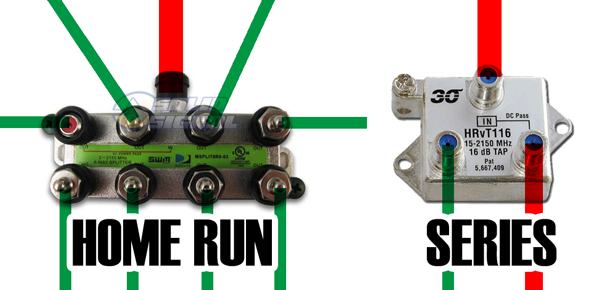Home Run Wiring. It’s a confusing term and a frustrating one as well. When property owners or restauranteurs hear that term, they may have no idea what it means. Or, they may simply know one thing: it’s more expensive.
Home run wiring has nothing to do with the home and it has nothing to do with baseball. The term means that every television or receiver has a dedicated line back to the distribution closet. Traditionally, hotels and other cable installations were done by using a single wire with a tap point at every television. Changing over to home run wiring can be expensive and time consuming and there isn’t a lot of understanding why it’s necessary.
In order to understand the need for home run wiring, it’s important to understand the actual difference between home run wiring and series wiring. In order to do that, you must first understand the difference between a splitter and a tap.
A splitter takes a single line and splits the current equally to multiple outputs. Look at the image on the left. The red line is current going in, and it is split evenly to all the outputs. The result is the green lines, which are all thinner than the red line. Each output on a splitter carries less current but every output carries the same current.
On the other hand, a tap does not equally split the current. One output will be much stronger than the other, as shown in the image on the right. The intention is that the stronger line goes on to be “tapped” again, while the weaker line serves the TV or receiver to which it’s connected. In this way, the strongest possible signal can reach the end of the line.
The advantage of series wiring is that it’s cheap. Running a line to 8 TVs will require one long line and 8 short lines. Using home run wiring in the same situation requires 8 long lines and that’s a lot of copper. However, series wiring has one major limitation: a failure at any point in the line affects everything “downstream” of it. It’s kind of like Christmas tree lights in that breaking the line anywhere will cause the entire string of lights to go out.
Series wiring is cheap to put in, but in a case where you’re pushing a big, fat digital signal down the line it just isn’t reliable. It also creates problems where two-way communication is needed, such as in DIRECTV SWiM systems. Think of home run wiring this way: The splitter is downtown, and there are 8 roads leading out of town, one to each house. To get downtown is easy: one road. Now think of series wiring. If you’re on a long road with 8 intersections, and you don’t know which one of them leads downtown, it’s going to take you a lot longer.
Home run wiring is easy to put in when you’re doing the initial install but it can be hard pushing 8 wires into a conduit designed for one. That’s why systems like the COM1000 use series wiring, but they don’t have the extra features found in the DIRECTV Residential Experience. In apartment buildings, home run wiring is really the only way to go because you don’t want people affecting their neighbors if they add a new TV. In the case of a bar or restaurant, there are plusses and minuses. The cost of home run wiring may be offset by not having to use a matrix switcher or modulator, and it will allow for ultimate flexibility because every TV can have unique programming.




